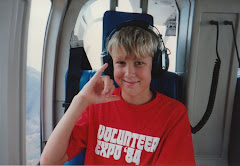On the other side of the ridge, I was happily filming some video when he hit me with the first of two surprises that day.
"Autorotation in three-two-one."
Without even giving each count a full second, he flattened the rotor blades and cut the throttle to enter an engineless descent. I was caught a bit by surprise, and you can see the lurch in my footage as gravity is momentarily lost.
"You asshole," I jabbed, jokingly. I tend to curse when I get suddenly spooked by heights, so much so that my first instructor instituted a three-expletives-per-flight rule.
 Besides being used for emergency landings, autorotation is the express elevator down in a helicopter. He was using it to quickly lose altitude down the long slope to our next objective, the seaside cliffs of the northern shore. Halfway down, it became apparent that our descent was too steep to clear the cliff edge and glide out over the sea.
Besides being used for emergency landings, autorotation is the express elevator down in a helicopter. He was using it to quickly lose altitude down the long slope to our next objective, the seaside cliffs of the northern shore. Halfway down, it became apparent that our descent was too steep to clear the cliff edge and glide out over the sea.Rather than re-engage the throttle, he chose to demonstrate a peculiarity of the helicopter's design. By allowing rotor rotation to slow to 90% of normal RPM, a Robinson R22 pilot can maximize the glide angle in an autorotation, buying more horizontal distance per altitude lost.
It's a maneuver not to be taken lightly. At any value below 97%, the Low RPM Horn begins wailing, alerting the pilot of the vulnerable condition. At any value below 80%, the rotor stalls, and you fall out of the sky.
So there we were, falling almost 2000 feet per minute without any engine power, the rim of a cliff looming to cut short our approach to the sea, and the Low RPM Horn lamenting our imminent demise. I'm proud to say I wasn't really fazed; I just kept filming.
My instructor's tactic worked, and we cleared the cliff with room to spare. I've shared a short clip below. As you watch it, notice how our altitude changes relative to the clouds as we float down from a mile high to nearly sea level.
I'll share my instructor's second surprise that day in another post.



















